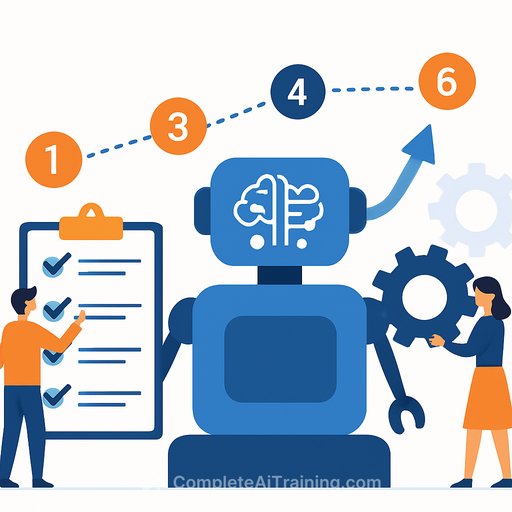AI Strategy for Maintenance: A Practical Playbook for Executives
There's pressure to "have an AI strategy," but few teams are confident in theirs. A 2025 study reported that just 1% of executives describe their AI rollouts as mature, and only a quarter have a clear roadmap. That gap is your opening.
Maintenance is where AI can pay for itself fast-less downtime, smarter parts spend, safer operations. Below is a simple, six-step framework your operations and maintenance leaders can execute without stalling out.
Source: McKinsey's State of AI (2025)
Six steps that turn AI from theory into uptime
1) Pick the right use case
Don't start with a tool. Start with a problem big enough to matter and small enough to win.
- What problems need solving? Identify the top three drains on cost, uptime, or safety. Think chronic unplanned downtime, PM overload, stockouts, or compliance misses.
- What reliable data can you access? Use data you already trust-CMMS work orders, PM history, parts transactions, failure codes. Clean it, structure it, and ship.
- What workflows can AI slot into? Improve how people already work: suggest PM intervals during planning, flag risky assets in the daily review, auto-draft work orders for supervisor approval.
2) Connect AI to business outcomes
Frame AI as a fix for a costly status quo. Show the leak; then show the patch.
- Executive objectives: Reduce unplanned downtime by 15%, cut parts working capital by 10%, lift PM compliance to 95%, improve OEE by 3 points.
- Cost-of-failure view: Prioritize assets where downtime is expensive or a safety risk. Lead with numbers, not hype.
- Narrative: "We're losing X per month to avoidable outages. Here's how AI-optimized PMs and smarter parts planning reverse it in 90 days."
3) Build a phased plan you can execute
Ship value early. Expand only after you prove it.
- Phase 1: Quick wins (0-90 days)
- Use work order history to optimize PM frequency and scope for top 10 assets.
- AI-assisted procedure drafting (techs approve before use).
- Dashboards for failure patterns and MTTR outliers.
- Phase 2: Scale (90-180 days)
- Forecast parts usage from work orders and optimized PMs to cut stockouts and excess.
- Auto-generate work orders for recurring issues; supervisors review and publish.
- Phase 3: Predict (180-365 days)
- Add IIoT sensors on the asset with the highest cost of failure.
- Predictive maintenance: anomaly alerts routed into your CMMS with human-in-the-loop validation.
4) Set clear goals and KPIs
Avoid the "silver bullet" trap. Define outputs and the actions that turn them into results.
- Outputs: Optimized PM templates, prioritized asset list, AI-drafted procedures, parts forecasts, anomaly alerts.
- Actions: PMs published and used, procedures approved by leads, forecasts driving buys, alerts converted to work orders.
- KPIs: Unplanned downtime (-15%), MTTR (-10%), planned maintenance percentage (+20 pts), PM compliance (≥95%), stockouts (-30%), parts turns (+15%), OEE (+2-3 pts).
5) Identify risks and how you'll mitigate them
Executives fund plans that handle risk head-on. Name the pitfalls and show your guardrails.
- Data quality: Data hygiene sprints; standardize codes; change requests flow through a data owner.
- Model reliability: Start with interpretable rules + simple models; monitor drift; quarterly recalibration.
- Safety and compliance: Human-in-the-loop approvals for any AI-generated procedure; traceability for audits.
- Change management: Pilot charters, tech champions on each shift, short "how-to" sessions, and visible wins.
- Integration risk: Use APIs your CMMS supports; sandbox first; staged rollout by site or line.
- Overpromising: Cap targets per phase; tie funding to delivered milestones.
6) Call the decision points and act now
Make the decisions that keep momentum.
- Decision points: Budget owner, success metrics, priority assets, data sources, vendor vs. internal build, approval workflow, privacy policy.
- Next 30 days: Confirm use case and KPIs; clean and label core data; draft pilot plan; pick champions; set baseline metrics.
- Days 31-60: Configure models and dashboards; publish optimized PMs for first asset group; enable approvals; report first deltas.
- Days 61-90: Expand to next asset group; turn on parts forecasting; formalize governance; present results and request Phase 2 funding.
Where to go from here
Most companies don't need more experiments. They need a strategy that the C-suite and the shop floor both trust. Pick problems that move the P&L, phase your roadmap, measure what matters, and keep the loop tight between insights and action.
If you want a concise overview of industry adoption patterns and pitfalls, this summary is useful: McKinsey's State of AI. If your leadership team needs focused upskilling by role, browse curated options here: AI courses by job.
Your membership also unlocks:






